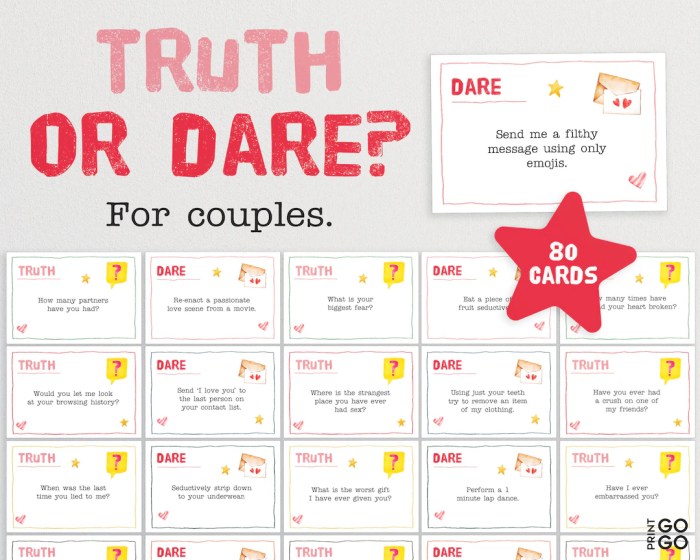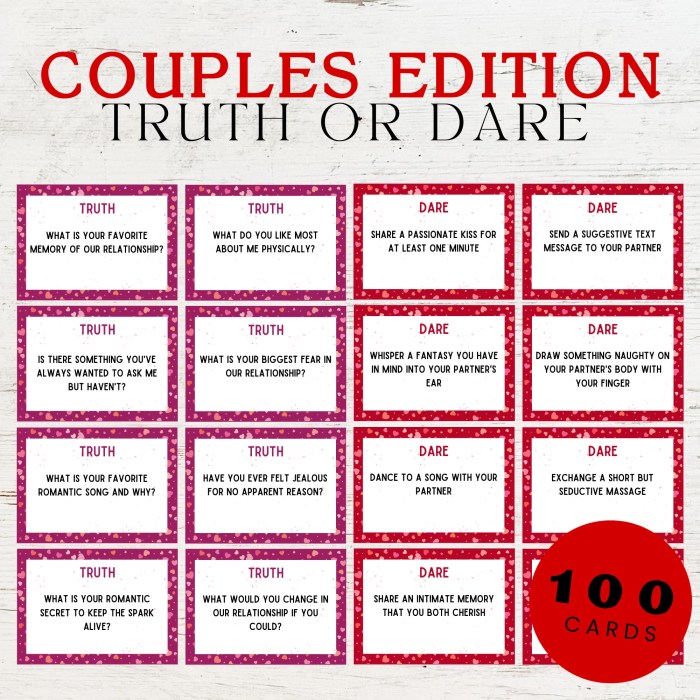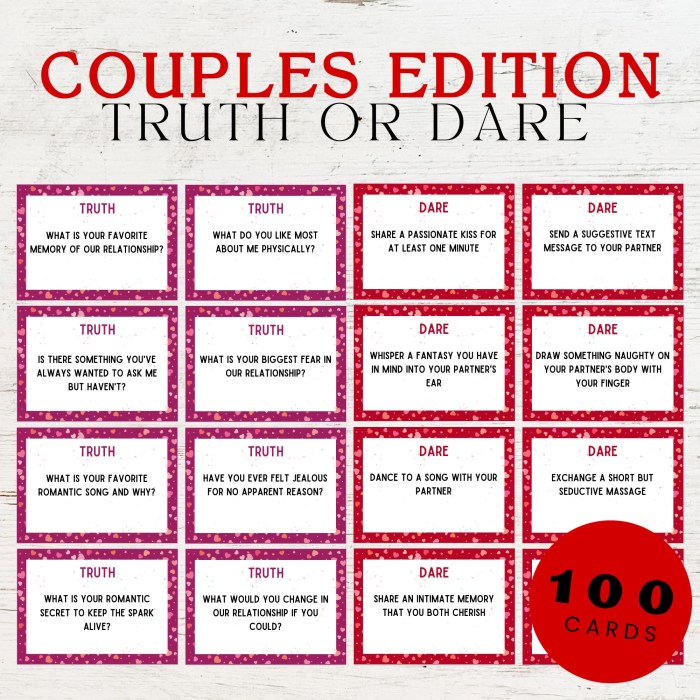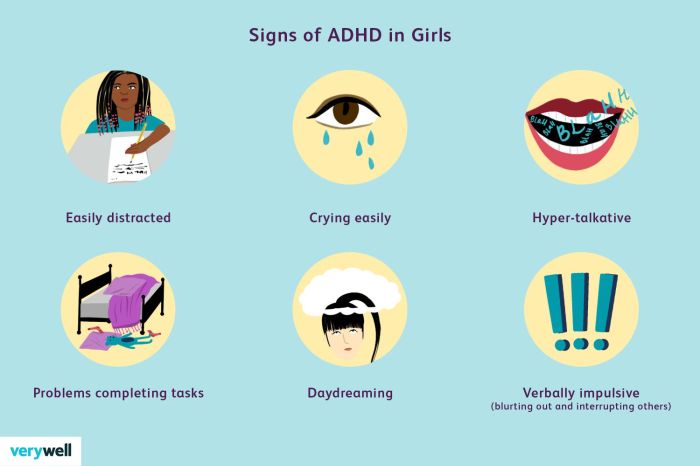Truth or Dare Questions for Couples: ignite intimacy and fun in your relationship. These games offer a unique way to explore each other’s personalities, deepen understanding, and create lasting memories. Whether you’re newly dating or celebrating years together, these carefully crafted questions and dares can lead to exciting conversations and playful interactions. The adaptable framework caters to various relationship stages and personalities.
This guide provides a comprehensive approach to creating a fun and engaging Truth or Dare game night. It covers everything from crafting thoughtful truth questions to designing exciting dare challenges, ensuring a smooth and respectful gameplay experience tailored to different couples.
Introduction to Truth or Dare for Couples
Truth or Dare games for couples are interactive activities designed to foster communication, intimacy, and playful fun. These games, often incorporating questions and challenges, encourage couples to engage with each other on various levels, revealing hidden aspects of their personalities and relationship dynamics. The shared experience can strengthen bonds and create lasting memories.The primary purpose of these games is to spark conversation and encourage vulnerability.
Common motivations include seeking deeper understanding of each other, overcoming shyness, and experiencing lighthearted challenges that can lead to shared laughter and closer connections. They can be particularly effective in reigniting passion or fostering playful interaction in long-term relationships.
Adapting Truth or Dare for Different Relationship Stages
Truth or Dare games can be tailored to suit various relationship stages. For newly dating couples, the focus can be on getting to know each other better through lighthearted questions. As relationships mature, the questions can delve deeper into shared history, values, and hopes for the future. Established couples can use the games to reignite the spark, reminisce about past experiences, and create fun, playful challenges.
Potential Benefits of Truth or Dare Games
These games can foster greater understanding and intimacy by prompting couples to share personal truths and experiences. Honest answers can reveal hidden facets of each partner’s personality, helping to create a deeper connection. The shared experience of playful dares can also lead to increased laughter, strengthening bonds and creating positive memories. However, they can also potentially lead to conflicts if not managed carefully.
Potential Drawbacks of Truth or Dare Games
Truth or Dare games, while enjoyable, can also present potential drawbacks. Careless or insensitive questions can cause discomfort or hurt feelings. Similarly, inappropriate dares could create tension or embarrassment. It’s crucial to maintain a respectful atmosphere and ensure that everyone feels comfortable participating. Unresolved conflicts or disagreements may resurface during the game, so it’s important to establish ground rules and expectations for behavior.
Framework for a Truth or Dare Game for Couples
This framework Artikels categories for questions and dares, offering a starting point for creating your own Truth or Dare game tailored to your relationship’s needs.
| Category | Example Truth | Example Dare |
|---|---|---|
| Fun Facts | What’s your weirdest childhood memory? | Do a silly dance for 30 seconds. |
| Relationship History | What was your first impression of your partner? | Act out your first date. |
| Shared Dreams | What’s one dream you’d like to achieve together? | Plan a surprise activity for your partner. |
| Values and Beliefs | What’s something you value most in a relationship? | Tell your partner three things you admire about them. |
| Personality Quirks | What’s your biggest fear? | Try a new food without knowing what it is. |
Creating Engaging Truth Questions
Truth questions are a vital part of any couples’ game, fostering deeper connection and understanding. They can be a catalyst for revealing hidden aspects of personality and relationship dynamics, but they must be crafted carefully to ensure a positive and enjoyable experience for both partners. Effective truth questions encourage vulnerability and trust, creating an environment where partners feel comfortable sharing their thoughts and feelings.Crafting engaging truth questions requires a thoughtful approach, moving beyond simple “yes” or “no” answers.
Open-ended questions that invite detailed responses are more likely to spark meaningful conversations and reveal interesting insights into the individuals and their relationship. The key is to strike a balance between curiosity and respect, avoiding any questions that might be perceived as invasive or potentially hurtful.
Categorizing Truth Questions by Topic
A structured approach to truth questions can make the experience more organized and engaging. Categorizing questions by topic allows for a more focused discussion on specific aspects of the relationship or personal life. This categorization also helps to ensure a variety of topics are covered, preventing the game from becoming repetitive or biased towards a particular area of discussion.
For example, a topic like “inside jokes” can lead to laughter and reminiscing, while “relationship history” provides a chance to reflect on past experiences.
Crafting Interesting and Thought-Provoking Questions
Different approaches to crafting questions can lead to diverse responses and interactions. Open-ended questions, inviting detailed answers, are preferred over closed-ended ones. Examples include questions about personal quirks, embarrassing moments, or hopes and dreams. Such questions encourage deeper introspection and facilitate a more meaningful exchange of thoughts and feelings. By focusing on specific areas of interest, the questions can lead to insightful discussions and shared experiences.
Open-Ended Questions for Detailed Responses
Open-ended questions are crucial for prompting detailed responses. They allow individuals to elaborate on their answers, revealing hidden nuances and personal perspectives. For instance, instead of asking, “Have you ever done something embarrassing?”, a more engaging question would be, “What’s the most embarrassing thing you’ve ever done, and what did you learn from it?”. These kinds of questions can unearth a wealth of information about the individual and their experiences.
Avoiding Invasive or Hurtful Questions
The core principle in crafting truth questions is to avoid any form of invasion of privacy or potential hurt. Questions that probe into sensitive areas or those that could trigger emotional distress should be avoided. This includes topics like past traumas, deep-seated insecurities, or potentially hurtful experiences. Questions should be designed to encourage positive and uplifting interactions, fostering a supportive environment for both partners.
Levels of Intimacy in Truth Questions
Maintaining the appropriate level of intimacy during the game is crucial for a healthy and positive experience. The following table demonstrates a tiered approach to question difficulty and intimacy level, helping you to structure your truth questions accordingly:
| Level | Question Example |
|---|---|
| Low | What’s your favorite color? |
| Medium | What’s a recent embarrassing moment? |
| High | What’s something you’ve always wanted to tell your partner but haven’t? |
Designing Effective Dare Challenges

Dare challenges, when thoughtfully crafted, can be a fantastic way to foster intimacy and shared experiences within a couple. They can be a fun outlet for playful competition and a catalyst for exploring new aspects of each other. However, it’s crucial to design dares that are not only entertaining but also safe, considerate, and appropriate for the relationship dynamic.Designing dares that resonate with the couple’s personalities and comfort levels is key to a positive experience.
This involves understanding the boundaries and preferences of both individuals, ensuring the dares are not overly demanding or potentially harmful. Careful consideration of the couple’s comfort level with physical, creative, and social interaction is crucial for a positive outcome.
Truth or dare questions for couples can be a fun way to spark conversation and get to know each other better. Sometimes, though, you need a little extra inspiration. The soundtrack from Scott Pilgrim vs. the World, Scott Pilgrim vs the World OST , is a perfect mood booster for these kinds of games. It’s the perfect background music for those adventurous, maybe a little quirky, truth or dare rounds.
Just remember to keep the questions playful and respectful, and the good times will surely roll.
Categorizing Dare Challenges
Understanding different types of dares allows for better tailoring to specific couples. Different categories, such as physical, creative, and social, cater to various interests and relationship dynamics. By recognizing the spectrum of activities, couples can select dares that align with their strengths and preferences.
Truth or dare questions for couples can be a fun way to spark conversation and intimacy. Sometimes, though, you need a little extra inspiration. For example, if you’re feeling a bit stuck in a rut, checking out Interpol’s Paul Banks cover of Iggy Pop’s “Gimme Danger” and “Sister Midnight” might just give you the creative boost you need to come up with some truly engaging questions.
These tracks are a great way to reignite the spark, and after listening, you’ll be brimming with fresh ideas for your next round of truth or dare. interpol paul banks covers iggy pop gimme danger and sister midnight listen Hopefully, this will make your next game of Truth or Dare with your partner even more exciting and memorable!
Physical Dare Ideas
Physical dares can promote physical interaction and connection. They often involve movement, shared activities, and physical touch, fostering closeness and playful competition.
- Teach your partner a new dance move, focusing on a specific genre (e.g., a salsa step, a tap routine). This promotes physical interaction and laughter.
- Create a series of physical challenges, such as a partner workout routine, that can be completed at home.
- Go for a themed scavenger hunt in a local park, where clues relate to physical actions or movements.
- Participate in a couples’ yoga or Pilates class, learning and practicing poses together.
Creative Dare Ideas, Truth or Dare Questions for Couples
Creative dares allow couples to express their artistic sides, fostering understanding and appreciation for each other’s unique talents.
- Write a short poem about your partner, highlighting their unique qualities and endearing characteristics. This can be a heartfelt exercise in appreciation.
- Create a collaborative piece of art, such as a painting, drawing, or collage, incorporating elements that represent each partner’s style and personality.
- Compose a song or musical piece together, using instruments or voices to create a shared artistic expression.
- Plan a surprise party for a friend or family member, incorporating elements that showcase both partners’ creative talents.
Social Dare Ideas
Social dares encourage couples to step outside their comfort zones, building communication and understanding through social interactions.
- Ask your partner for advice on a personal issue or problem, actively listening to their perspective and suggestions.
- Attempt a new social skill, such as public speaking, together, preparing a short speech or presentation to deliver to a small group.
- Attend a social gathering or event where you’ll encounter new people, engaging in conversations and sharing your experiences with your partner.
- Go to a karaoke bar or open mic night, where you can sing or play music together in front of an audience.
Levels of Daring and Impact
The level of daring significantly impacts the relationship dynamic. Subtle dares can foster lighthearted interaction, while more challenging dares can push the couple to explore deeper levels of intimacy and trust.
| Category | Dare Example | Potential Impact |
|---|---|---|
| Low Daring | Teach your partner a new dance move. | Encourages playful interaction and shared learning. |
| Medium Daring | Write a short poem about your partner. | Promotes self-expression and deeper appreciation. |
| High Daring | Ask a stranger for a date, with your partner. | Requires significant trust and communication. |
Tips for a Smooth Gameplay Experience
Truth or Dare for couples can be a fantastic way to connect and have fun, but it’s essential to navigate the game with care and consideration. Setting a positive tone and establishing clear guidelines ensures everyone feels comfortable and respected throughout the entire experience. A smooth game night leads to lasting memories and strengthens the bond between partners.
Maintaining a Lighthearted Atmosphere
Creating a safe space where everyone feels comfortable sharing is crucial for a positive experience. Encourage laughter and lightheartedness throughout the game. This can be achieved by actively participating in the playful spirit of the game and avoiding overly serious or judgmental comments. Remember, the goal is fun, not to put anyone on the spot.
Respectful Communication
Active listening is key to a respectful game. When someone shares a truth, listen attentively and respond thoughtfully, even if you disagree. Similarly, when someone receives a dare, encourage them to complete it in a safe and responsible manner. Avoid making critical or dismissive comments about their answers or dares. A supportive and encouraging attitude fosters a more enjoyable atmosphere.
Handling Disagreements or Uncomfortable Situations
Disagreements may arise during a game night, and it’s essential to have a strategy for addressing them. If a disagreement occurs, take a moment to pause and calmly discuss the issue. Emphasize the importance of respecting each other’s perspectives. If the disagreement becomes heated, it might be best to temporarily suspend the game and return to it later.
Prioritizing understanding and empathy can help diffuse any tension.
Adapting to Different Relationship Dynamics
Couples have unique dynamics and preferences. Consider these differences when playing Truth or Dare. If one partner is more reserved, offer them gentler truths or dares. If another partner is more outgoing, cater to their enthusiasm while still maintaining a respectful atmosphere. Adjust the level of intimacy based on the couple’s comfort levels.
Truth or Dare questions for couples can be a fun way to spark conversation and reveal hidden depths. Sometimes, a little vulnerability can be a good thing. For a truly unforgettable experience, check out this incredible duet of Stevie Nicks and Harry Styles performing “Landslide” – watch stevie nicks and harry styles duet on landslide. It’s a powerful reminder of the beauty of connection and a great way to reconnect after a few truth or dare rounds! Thinking about some heartfelt, personal truth or dare questions for your next game night?
Sample Script for a Safe and Enjoyable Game Night
“Welcome to our Truth or Dare night! Remember, the goal is to have fun and connect. Let’s start by setting some ground rules: be respectful of each other’s answers and dares, and make sure everyone feels comfortable. If someone feels uncomfortable with a question or dare, we can skip it or modify it to make it more suitable. Now, let’s get started! First question, for you [Partner’s name]…Truth or Dare?”
“[Partner’s name] chooses Truth. Now, ask your partner a truthful question about themselves that you’ve always wanted to know, but make it lighthearted and fun.”
“[Partner’s name] chooses Dare. Let’s ensure the dare is something they can complete safely and responsibly.”
“Remember to listen actively and respond with kindness. If anyone feels uncomfortable at any point, let’s take a break and chat about it. Have fun!”
Adapting Truth or Dare for Specific Couples: Truth Or Dare Questions For Couples

Truth or Dare, a classic game of playful revelation and challenge, can be a fantastic way to strengthen bonds and spark laughter within a relationship. However, its effectiveness hinges on tailoring the experience to the specific dynamic of the couple engaging in it. Understanding the nuances of their relationship, communication styles, and personalities allows for a more enjoyable and meaningful game experience.This section delves into the crucial aspects of adapting Truth or Dare to cater to various couple types, ensuring the game remains lighthearted and enriching for all involved.
It emphasizes the importance of understanding individual personalities and relationship dynamics to create a game that strengthens connections rather than causing friction.
Relationship Length and Stage
Understanding the stage of a couple’s relationship is essential. Freshly coupled individuals may benefit from questions focusing on early relationship experiences, while long-term couples might find more value in questions about shared dreams or challenges overcome together. Questions should reflect the maturity and intimacy level of the relationship.
Communication Styles
Couples with differing communication styles require careful consideration. If one partner is more reserved, the questions and dares should be designed to encourage participation without putting undue pressure on them. Conversely, couples who enjoy open communication might benefit from more probing questions that promote deeper discussion.
Individual Personalities
Consider each partner’s personality when crafting questions and dares. Introverted individuals may feel more comfortable with truths that focus on personal preferences, while extroverted individuals might enjoy dares that involve engaging with the outside world. This understanding allows for a tailored experience that suits each personality.
Framework for Long-Term Couples
For long-term couples, the game can explore the evolution of their relationship, reflecting on shared memories and growth. Incorporating open-ended questions about mutual dreams and aspirations can create a profound bonding experience.
Interests and Hobbies
Tailoring the game to shared interests or hobbies can add an extra layer of enjoyment. For instance, a couple passionate about travel could engage in dares that involve researching a new destination together or planning a future trip. This approach helps to integrate their common interests into the game.
Incorporating Humor and Lightheartedness
Humor is key to a successful Truth or Dare session. Weaving in lighthearted questions and dares that tap into shared inside jokes or funny memories can create a genuinely enjoyable experience. Examples could include silly dares, questions about memorable moments, or even recreating a funny photo or video. Questions should aim to be fun and engaging, fostering a positive atmosphere.
Last Point
In conclusion, Truth or Dare for couples can be a powerful tool for connection and fun. By thoughtfully crafting questions and dares, you can foster deeper understanding, build intimacy, and create shared experiences. Remember to adapt the game to your relationship’s unique dynamics, prioritizing respect, communication, and laughter. The key is to create a safe space where everyone feels comfortable and valued.
Enjoy the journey of discovery and connection!




























